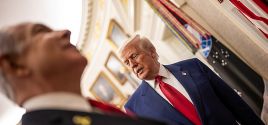A Brewing Terror: The U.S. Government's Alcohol Poisoning Programby SovereignSonPolice State USA Nov. 14, 2013 |
Popular 
Report: Hamas Says Witkoff Promised to Lift Gaza Blockade in Exchange for Edan Alexander

Ben Shapiro, Mark Levin and Laura Loomer Warn of Foreign Influence... From Qatar

Eloy Adrian Camarillo, 17, Arrested in Shooting Death of Infowars Reporter Jamie White

NYT: Trump Ended War With Houthis After They Shot Down U.S. Drones, Nearly Hit Fighter Jets

Trump Advisor to Washington Post: 'In MAGA, We Are Not Bibi Fans'
 Hardly had the last wisps of gun smoke faded into the ether of post-World War I Europe before America found herself embroiled in an epic domestic struggle, championed by an uncanny conglomerate of religious zealots, women’s rights advocates, and racists. America’s War on Alcohol infamously gave rise to organized crime, widespread violence, and rampant corruption — and that’s just speaking of the government. One forgotten aspect of the prohibition era was the government’s disturbing and deliberate efforts to poison people who broke the law. Alcohol prohibition came in the form of a sequoian piece of legislation whose seed took root over half a century prior. The Volstead Act — as the eighteenth amendment to the U.S. Constitution was known — forbade the sale and transportation of alcohol (but not its possession or consumption). The law drove drinkers to regional black market sources to quench their thirst. In Chicago, apartments were transformed into complexes of small illicit distilleries. Citizens living near the Canadian border subsisted on imports. Some New Englanders procured spirits that were denatured for industrial use. It was mostly these odious cocktails that lead to the deaths of so many people; killing forty-one of them in New York City on a single New Year's Day. Fifty-one years before Nixon declared his War on Drugs, Prohibition likewise proved to be an era for a host of opportunists borne from both sides of the law. Entrepreneurs building fortunes off the backs of rum-runners sailing from the Bahamas to Baltimore in turn lined the pockets of coast guard officials and police on the take. Thugs like Stewart McMullin were drawn to law enforcement because of the great sums of money that they could extort from prohibition violators. McMullin sandwiched armed robbery and fraud between homicidal episodes; his first victim was claimed as a teenager, his second as a Prohibition agent. Bootleggers were seduced by the legal and plentiful availability of industrial spirits; even more so by its tax-exempt status. The government’s efforts were could do little to stem the flow of liquor. There was simply no way that a law could curtail the heavy demand for a product so ingrained in American culture. As its most invested crusaders’ faith — formerly so buoyant — began to sink, the more desperate the prohibitionists became. The U.S. Government began to maliciously poison certain alcohol supplies to attempt to keep people from drinking it. Edward Behr, author of Prohibition: Thirteen Years that Changed America, wrote that by 1927 more than 50,000 Americans may have been fatally poisoned by alcohol produced under the auspices of the U.S. government; many more people were rendered blind or paralyzed. Indeed, the government gave no regard for the lives destroyed upon consumption. In a sick irony, their policies were intentionally destroying lives, while simultaneously being promoted as saving lives. The more conscientious bootleggers employed chemists who extracted the noxious chemicals like sulfuric acid, formaldehyde, and iodine from the potable ethanol before putting their wares on the market. Sadly, not all of the bootleggers were conscientious. Patrons absent political affluence, not blessed with ecclesiastical connections to sacramental Chardonnay or homesteading relatives fermenting hard cider in their cellars, gambled with their health every time they imbibed. A particularly insidious poison slipped into denaturing formulas was methyl alcohol, a pleasant-smelling byproduct of the distillation process and chemical used in manufacturing that attacks the digestive, urinary and nervous systems of its victims. In large enough doses, it leads to ocular destruction and death. Wayne Wheeler, the lobbyist who headed the powerful Anti-Saloon League and the architect behind the Volstead Act, was unmoved by the carnage the poisoning program wrought. "The government is under no obligation to furnish people with alcohol that is drinkable when the Constitution prohibits it," he said. "The person who drinks this industrial alcohol is a deliberate suicide." But the public’s awareness of the program is unclear. The Anti-Saloon League not only promoted methyl alcohol’s inclusion as a denaturant, but opposed labeling regulations meant to deter diversion of the products that contained it despite the proscriptions of the Pure Food and Drug Act 0f 1906. Compounding the issue, bootleggers skillfully adorned their counterfeit bottles of Canadian and European liquors with quality facsimile labels. Wheeler’s callous attitude — a sad foreshadowing of the treatment perpetrators of similar victimless crimes in the coming decades would face — prompted Columbia University President Dr. Nicolas Murray Butler to declare the poisoning program “legalized murder.” Even Andrew Mellon, the dour-countenanced Secretary of the Treasury, the man of ample ambivalence who presided solemnly over the Prohibition Bureau called the program “inexcusable.” Nevertheless, as a testament to the influence of driven and monied special interest groups, Wheeler and his ASL convinced Mellon that methyl alcohol must remain a fixture of the denaturing program until more repulsive, less lethal alternatives could be discovered. As there were potent emetics among the some seventy-five other chemicals already in the official formulary, this stance was nonsensical as well as heartless. As one Chicago Tribune article in 1927 stated: "Normally, no American government would engage in such business. "¦ It is only in the curious fanaticism of Prohibition that any means, however barbarous, are considered justified."The Volstead Act stood on shaky soil the moment it emerged as law of the land on the morning of January 1, 1920. It wasn’t until the Great Depression that tremors began to run through it. The eighteenth amendment finally came crashing down in 1933 as lawmakers concluded that revenue from the federal income tax was too weak to support a recovery. As new life was breathed into the American distillation trade, the rash of poisonings became a haunting memory. The thirteen years of alcohol prohibition caused a profound amount of damage to the country, but provided a valuable lesson to Americans that would be soundly ignored for the rest of the 20th century. Prohibitive laws of the nature of the Volstead Act invariably lead to public health crises. Such is the case with modern drug prohibition. The most frightening contemporary example is probably the recent scourge of krokodil, the horrifying flesh-decaying drug that has made the implausible leap across the Atlantic from the slums of Russia, where it was cooked up as a substitute for the much maligned, more benign narcotic heroin. Interestingly, heroin itself is a substitute for the natural opiates repudiated by a puritanical populace. If laws prohibiting natural, less destructive stimulants were never put to paper, it’s unlikely we’d know the horrors of meth, krokodil, or bath salts. Draconian cannabis enforcement has lead to innumerable tragic consequences, yet usage is on the upswing. A great many parallels can be drawn between alcohol prohibition and drug prohibition. Among these are the destructive economic consequences, the state-sanctioned violence, the profitable black markets, and the outright failure of the policies themselves. One of the less recognized parallels is the government’s callous disregard for public health outcomes directly influenced by their exertion of prohibitionist power. _ Police State USA is a volunteer, grassroots alternative media outlet dedicated to exposing the systemic formation of an American police state. |



